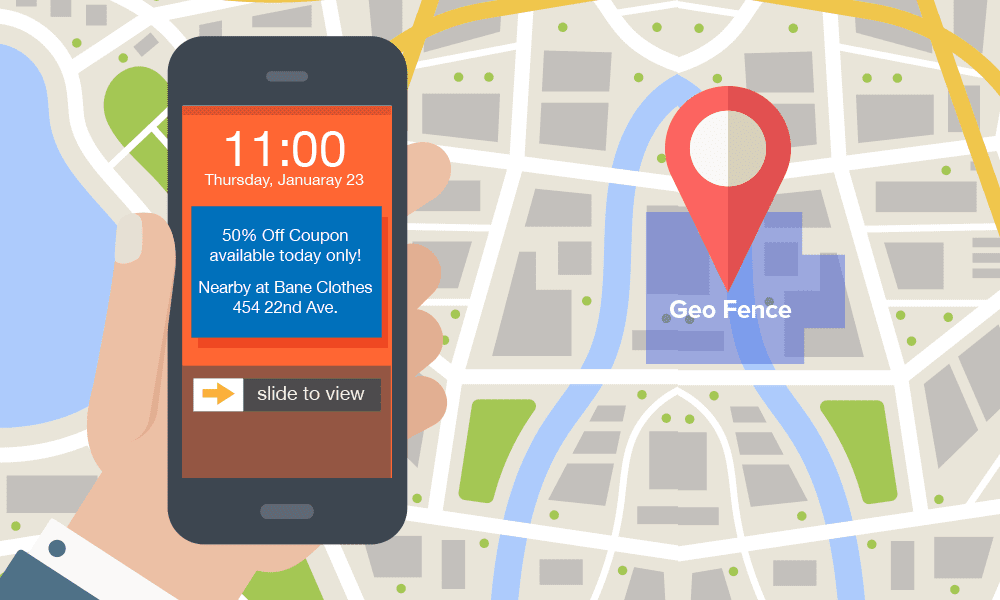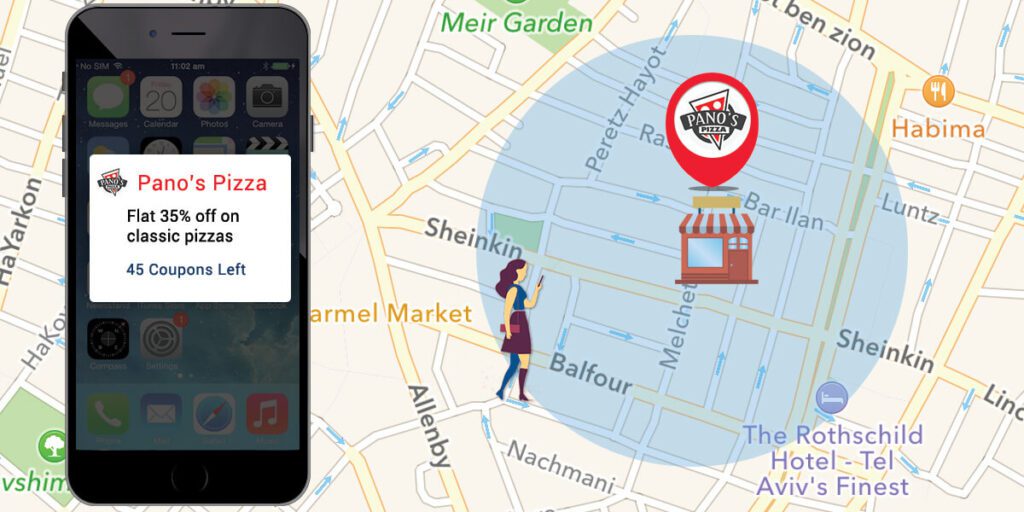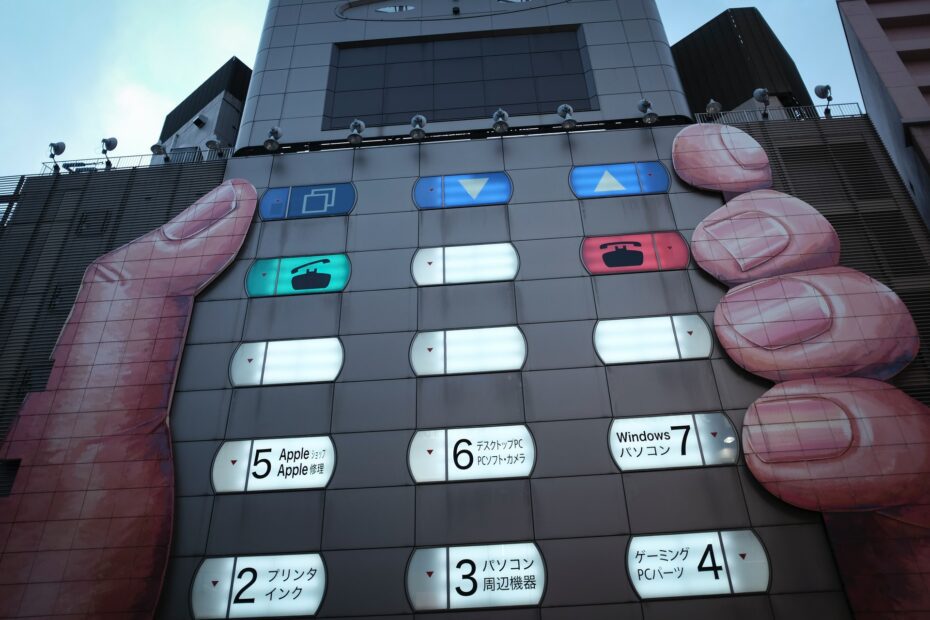Geofencing is a digital marketing tool that allows marketers to target specific geographical areas.
This tactic provides an opportunity for B2B companies to reach customers in their area and increase awareness of their products or services.
Geo-fences are virtual boundaries around a geographic location, like your office building or store.
When someone with the app enters this geo-fence, they receive a notification from you on the app about your company’s latest product or service offer.
Geo-fencing also offers businesses more information about what people are looking at when they enter these locations, so you can make decisions based on customer preferences and interests.
With geofencing technology, it’s easier than ever for small business owners to reach potential customers near their businesses.
By knowing the exact locations of your customers and reaching them with targeted marketing campaigns, you can improve sales and grow your company.
Let’s explore what is geofencing and how geofencing can be used for targeted digital marketing campaigns.
1. What is Geofencing and how does it work?
Geofencing is a location-based method of marketing that uses GPS and GIS (geographic information system) to deliver personalized messaging based on proximity to a specific area, store, or establishment.
Companies like Google and Facebook are already using geofencing to send messages about local businesses to those who have downloaded their apps, but this method is limited by only targeting users who have downloaded your app.
Now, there are tools that use geofencing to trigger a message about your business when a customer enters or exits a specific area.
For instance, if you own a small local business that needs foot traffic, say an ice cream shop, you could create a geofence around the area surrounding your store and deploy special offers for those who enter the zone.

2. How Geofencing can be used for digital marketing campaigns
Companies can use geofencing for localized marketing campaigns of all kinds, including:
Targeted digital advertising:
You can create specific ads to run when you know users are in a certain location.
These ads could be for your business’s products or services, or they could advertise one of your partners’ products and services.
Local push notifications:
You can create targeted messages that are delivered to the users in your specific geofence.
These messages could be about a new product you’re launching, or they could highlight an upcoming sale on specific products from your company.
Demographic targeting:
You can use geofencing to understand more about your customers.
When a customer enters or exits your geofence, you can see their approximate age and gender, based on a wide variety of factors including distance from the store, time of day, and a number of stops at other businesses along the way.
Think about how you can use this information to serve your customers better.
Geofencing is one of the best ways for businesses with a physical presence to connect with a larger number of customers.

3. Pros and cons of using geofences for targeted digital marketing campaigns
The main benefits of geofencing for digital marketing are its scalability, cost efficiency, and high rate of engagement.
Because only people who download the app will receive your message, you’ll be able to reach a larger audience than traditional physical ad methods.
For example, in the case of an ice cream shop with geofencing, only people who have downloaded the app will receive the offer and be able to redeem it.
With geofencing, you can also target multiple areas around your business, increasing your total potential reach.
Geofencing for marketing allows you to provide customers with more customized deals and offers based on their interests and preferences.
Because this form of marketing is location-based, it only targets people who are nearby.
This means that you’ll be able to reach a highly targeted audience with your ad campaigns and offers.
Geofencing can boost customer engagement by providing customers with relevant information when they need it.
4. Examples of successful geofence-based digital marketing campaigns
A Vietnamese restaurant in Chicago received a 22% increase in revenue after it began sending push messages to customers within a certain radius of the restaurant.
By targeting people who were near the restaurant but hadn’t visited recently, this business generated new sales from current customers and increased its customer base.
This year, Old Navy is focusing on using geofencing to changing customer shopping habits.
By sending push notifications to customers who visit the mall, but haven’t visited its store recently, this company is attempting to increase foot traffic and sales.
Using geofencing as a marketing tool can be useful for small businesses too.
5. Benefits of Geofencing for Small Businesses
Small businesses can provide deals or discounts when customers come into the store.
For example, an ice cream shop could offer a free scoop if a customer redeems the deal via their app and checks in at the store.
Encouraging new customers to download the app, while also providing targeted marketing campaigns for current customers can encourage repeat visits.
Geofencing for small businesses allows you to engage with an immediate audience when they’re nearby and schedule messages that will reach your customer at a later time.

Additionally, geofencing is relatively inexpensive compared to other advertising methods and can be more cost-effective than other digital marketing channels.
Suggested Reading: Free Web Hosting For Small Business Websites?
6. Common mistakes to avoid when using geofences in a campaign
Geofencing for marketing campaigns involves more than just downloading the app and setting up geofences.
If you want to see a positive ROI, you’ll need to plan your campaign carefully.
Some businesses assume that sending push notifications or special offers will yield good results, but they do not account for how these types of messages are received.
For example, if a customer downloaded the app but hasn’t opened it in several days or weeks, they may not be interested in the promotional messages you send.
Geofencing is meant to boost engagement with your existing customers.
Instead of sending out general messages and deals, try segmenting your audience based on demographics and behavioral trends.
For example, you could send messaging to people who haven’t used the app in over a month or reached out to customers who are within two miles of your store and have not purchased anything for months.
A common mistake businesses make is not using geofences in relation to their business.
7. Five tips for using geofencing effectively
If you want to use geofences, make sure your customers download the app.
It’s important to note that only people who have downloaded your app will receive custom notifications and offers from your business.
A common error is forgetting to clarify what a user will receive when they check-in at a certain location.
Customers may be confused when they get push notifications or special offers if they don’t understand how to use your app or why they are receiving them.
By setting up clear terms of service, customers will have a better understanding of what messages and discounts they can expect from your company!
Geofences should serve as an additional channel when used at the right time and place.
Geofencing is not a long-term strategy for business growth, it’s meant to be used as an additional marketing tool.
Conclusion:
In my opinion, geofencing is a powerful marketing tool when used correctly.
It allows companies to target their audience based on how far they are from the store or restaurant and send messages that will have an immediate impact on sales, while also providing customers with discounts and special offers if they visit in-store.
Good luck!

Ali is a digital marketing blogger and author who uses the power of words to inspire and impact others. He has written for leading publications like Business2Community, Inc. Magazine, and Marketing Profs. When not writing, he enjoys spending time with his family.
